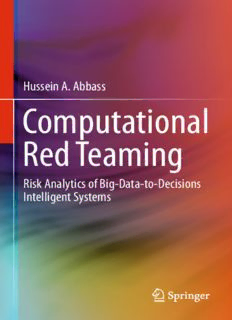Table Of ContentHussein A. Abbass
Computational
Red Teaming
Risk Analytics of Big-Data-to-Decisions
Intelligent Systems
Computational Red Teaming
Hussein A. Abbass
Computational Red Teaming
Risk Analytics of Big-Data-to-Decisions
Intelligent Systems
123
HusseinA.Abbass
SchoolofEngineeringandInformationTechnology
UniversityofNewSouthWalesAustralia
Canberra,ACT,Australia
ISBN978-3-319-08280-6 ISBN978-3-319-08281-3(eBook)
DOI10.1007/978-3-319-08281-3
SpringerChamHeidelbergNewYorkDordrechtLondon
LibraryofCongressControlNumber:2014951509
©SpringerInternationalPublishingSwitzerland2015
Thisworkissubjecttocopyright.AllrightsarereservedbythePublisher,whetherthewholeorpartof
thematerialisconcerned,specificallytherightsoftranslation,reprinting,reuseofillustrations,recitation,
broadcasting,reproductiononmicrofilmsorinanyotherphysicalway,andtransmissionorinformation
storageandretrieval,electronicadaptation,computersoftware,orbysimilarordissimilarmethodology
nowknownorhereafterdeveloped.Exemptedfromthislegalreservationarebriefexcerptsinconnection
with reviews or scholarly analysis or material supplied specifically for the purpose of being entered
and executed on a computer system, for exclusive use by the purchaser of the work. Duplication of
this publication or parts thereof is permitted only under the provisions of the Copyright Law of the
Publisher’slocation,initscurrentversion,andpermissionforusemustalwaysbeobtainedfromSpringer.
PermissionsforusemaybeobtainedthroughRightsLinkattheCopyrightClearanceCenter.Violations
areliabletoprosecutionundertherespectiveCopyrightLaw.
Theuseofgeneraldescriptivenames,registerednames,trademarks,servicemarks,etc.inthispublication
doesnotimply,evenintheabsenceofaspecificstatement,thatsuchnamesareexemptfromtherelevant
protectivelawsandregulationsandthereforefreeforgeneraluse.
While the advice and information in this book are believed to be true and accurate at the date of
publication,neithertheauthorsnortheeditorsnorthepublishercanacceptanylegalresponsibilityfor
anyerrorsoromissionsthatmaybemade.Thepublishermakesnowarranty,expressorimplied,with
respecttothematerialcontainedherein.
Printedonacid-freepaper
SpringerispartofSpringerScience+BusinessMedia(www.springer.com)
To God,forcreatingour mindsasthebest
computationaldevices tored team
To mytwo sons,lifepartner,dad andmom,
brothersandsisters,teachers,students,
colleagues,andthoseangelswho believein
me, thankyou forbeingthebestsocialreality
toshapemy mind
Preface
Thisbookisaboutelitetypesofthoughtprocessesandarchitecturesforbigdataand
modelingthatcanenablesmartandreal-timedecisions.Today’sworldisabundant
with data and models; many new problems are formulated and solved everyday;
many artificial-intelligence, mathematical, and statistical models exist, but there
is a lack of scholarly work to demonstrate how to bring these data, models, and
opportunitiestogether to produce value for organizations.This book does exactly
that and is written in a style designed to bridge management and computational
scientists.
This is a book about Computational Red Teaming (CRT): a computational
machinethatcanshadowtheoperationsofanysystem.TheShadowCRTMachine
canthinktogetherwith,oronbehalfof,thesystembyasking“what–if”questions,
assessing threatsandrisks, challengingthesystem, environment,andcompetitors,
andusingitswell-engineeredpredictivemodelsandcomputationalthinkingtoolsto
maketherightdecisionattherighttime.
Red Teaming (RT) is traditionally a decision-aidingart used by the military to
roleplayanadversary,playthedevil’sadvocateagainstone’sownconcepts,plans,
strategies,orsystemsto“testandevaluate”themtoimprovedecisionmaking.This
book has been written to distill general principles from RT, and generalize and
transform RT, the art, into CRT, the science. The discussion will depart from the
military contextto demonstrate the utility and applicability of CRT to individuals
andorganizations.CRT transformsthe classical “test-and-evaluation”processto a
continuousandproactive“test-and-redesign”process.
CRT meanssystemic and scientific RT. The word “computational”emphasizes
the necessity for systemic and computable steps that can be executed by humans
and computers alike, and allows for an evidence-based decision-making process
that can be traced to causes. Many tools discussed in this book can be employed
byusingpencilandpaper,andcanequallybescaleduptobigdataandbigmodels
thatexceed humancognitiveprocessingand classical computerabilities. With the
advances that have been made in fields such as computational intelligence, data
analytics, optimization,simulation,systems thinking,and computationalsciences,
today,wehavethetoolstoimplementCRTinsilico.
vii
viii Preface
Analytics is the science for transforming data to decisions. CRT uses risk
analytics,whereriskisthefocalpointofthedecision-makingprocess,andchallenge
analytics, where actions and counteractions are designed just across the system
performanceboundary,totestandredesigntherightdecisionsforanorganization.
CRT creates opportunities for individuals, organizations, and governments by
groundingRTinsystemanddecisionsciences,andbyidentifyingthearchitectures
requiredtotransformdataintodecisions.
Risk analytics and challenge analytics, jointly, create the CRT world of this
book. The part of the world that treats risk analytics examines what risk is, and
demonstrateshowevidence-baseddecisionsmustalwaysbedrivenbyriskthinking.
Thepartofthe worldtreatingchallengeanalyticsstructuresthe conceptofwhata
challengeis,discusseshowtosystematicallyandautonomouslydesignanddiscover
challenges, and how to challenge an individual, organization,or even a computer
algorithm.
Over six chapters, CRT will be presented. Chapter 1 brings the reader inside
the classical world of RT. It explains the philosophy of this art, and presents a
story to demonstrate that the art of RT can benefit each individual, not only large
organizations. The steps for implementing an RT exercise are explained, and the
characteristicsofasuccessfulRTexerciseandtheethicsofRTarediscussed.
Thebookthensweepsintothetwobuildingblocksofriskanalyticsandchallenge
analytics that form the scientific principles for CRT, the science. Chapter 2 uses
a systems approach to establish the basis for risk thinking and challenge design.
Materials in the chapter cross the boundaries of uncertainty and risk, intentional
anddeliberateactions,anddeliberatechallengestothesystemsapproach,skillsand
competencytoshapeandinfluenceperformance.
Chapter 3 presents the big-data-to-decisions CRT. The chapter introduces and
brings together the architectures and building blocks used to design and develop
the computational environment that supports CRT. This chapter presents a gentle
introductiontoexperimentation,optimization,simulation,datamining,andbigdata
beforepresentinghowthesetechnologiesneedtoblendtoofferCRTarchitectures.
TheCRTsciencereliesonefficienttoolstounderstandthefuture,andallowsan
effectiveunderstandingof howto analyze“messy spaces,” as wellas discoverthe
rightmethodstodeconstructcomplexorganizationsandtheintermingledphysical,
cyber, cognitive, and social domains (PC2SD). Beginning by offering scenarios
to prompt thoughts about the future and concluding with control mechanisms for
networksand generationof effects, Chap. 4 complementsthe computationaltools
presented in Chap. 3 with the necessary system-thinking ingredients to transform
computationalmodelsintoeffectivestrategictools.Thischapterdiscussesplanning
scenarios,andthecomplexityarisingfromtheinteractionofeffectsinthePC2SD.
It presents two models to manage this complexity:a model to transform complex
organizationsintosimple buildingblocksforanalysis,and a modeldiscussingthe
operationsrequiredtoanalyzeandgenerateeffectsincomplexnetworkedsystems,
thatformthebasisforathinkingmodelsuitabletodesignandformcyber-security
operationsandcomplexsocial-engineeringstrategies.
Preface ix
Chapter 5 complements the materials by presenting three case studies of
increasingcomplexity.Theseareadoptedfromtheauthor’sresearch.Thepurposeof
thesecasestudiesistoprovideexamplestoguidethereaderinadoptingthelessons
gleanedfromthisbook.Thecases are discussed in plain languageandprovidean
overviewofthelogicbeneatheachcase:whatwasdoneandhow.Thefirstcasestudy
demonstratestheuseofCRTtochallengeandevaluatewell-designedalgorithmsfor
aircraft-conflictdetection.Thesecondcasestudypresentsagameusedtochallenge
ahuman.Thethirdcasestudypresentsalarge-scaleexperimentthatcombinesmany
elements of this book. This experiment is aimed at designing a Cognitive-Cyber
Symbiosis (CoCyS; pronounced “cookies”) environmentfor air-traffic controllers
insafety-criticaldomains.CoCySisintroduced,inadditiontotheCRTexercise.
The last chapter (Chap. 6) concludesthe book and offers some reflections and
ideasforfutureworkonCRT.
Thereaderisencouragedtoreadthebookinchapterorder.Regardlessofwhether
the readersfind the informationtoo easy or too difficult, they are advised to keep
reading to the end. When the last chapter is reached, the ideas will be connected
despitesomeconceptsmaystillseemtobeconfusing.However,bytheendofthe
book, the reader is expected to know what CRT is all about to the extent that the
book can be read again (and again) to digest some of the most difficult concepts
encountered.
Last, but not least, the author is eager to hear comments, good or otherwise,
from the readers. Please forward any comments to the author’s email address at
hussein.abbass@gmail.com.Theauthorasksthereadertoredteamthisbook;only
thenwillthereader’sownjourneytowardCRTbegin.
Canberra,ACT,AustraliaandSingapore, HusseinA.Abbass
August2014
Description:Written to bridge the information needs of management and computational scientists, this book presents the first comprehensive treatment of Computational Red Teaming (CRT). The author describes an analytics environment that blends human reasoning and computational modeling to design risk-aware and e

